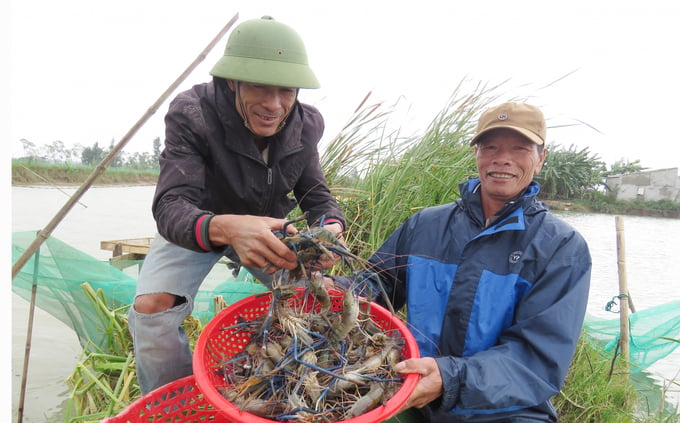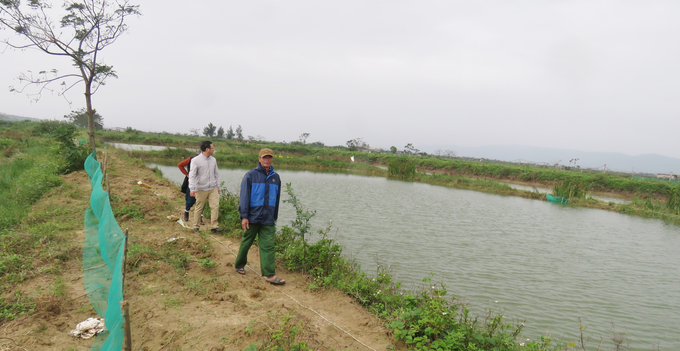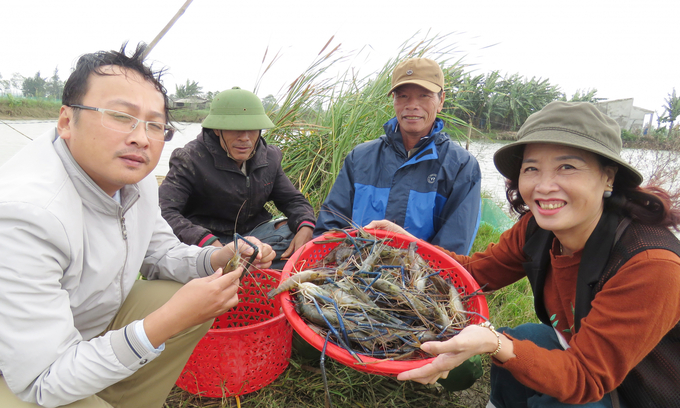In the outer fields of Dong Trach Township (Bo Trach District, Quang Binh), the shrimp ponds are connected, so the wind is cool. Mr. Pham Van Hoan, Chairman of Dong Trach Township People’s Committee, introduced, “Several years ago, this area was a single-crop rice cultivation, so we could only see the poor vines, strabismus and fields. After the effective crayfish farming, many families boldly switched rice to shrimp. The poor are very happy when they have a shrimp. In the field there are always shadows of people. People started getting rich in this poor area.”
The income is 3-4 times higher than rice cultivation
Mr. Tran Thanh Hai, director of Quang Binh Agriculture and Fisheries Extension Center, said that since 2020, the center has implemented an all-male giant freshwater shrimp farming model on inefficient rice-growing land in Dong Trach Township (District 10). Bo Trach) with a size of 6 households, a trial cultivation area of 3ha. “In the first harvest, jumbo freshwater shrimp grew well, had few diseases, and adapted to local ecological conditions. The cultivation season is relatively short, suitable for the growing season in Quang Binh, so the risk of being washed away by floods can be limited. The profitability is 3-4 times higher than rice cultivation,” said Mr. Hai.

The conversion of inefficient rice land into a giant freshwater shrimp farm in Dong Trach gives people a new direction. Photo: Tam Phung.
We went to Dong Trach township, where many households were converting inefficient rice land into all-male jumbo freshwater shrimp farming. Mr. Phan De, one of the households in Dong Trach Township participating in the model, said this year the family boldly converted 6 hectares of inefficient rice land to conduct experimental breeding of only male king freshwater prawns. At first the family was quite surprised as they didn’t know much about the cultivation process and techniques. But thanks to the technical guidance of the staff of the Provincial Center for Agriculture and Fisheries Extension, they soon had access to the technical processes of how to take care of the shrimp farming and how to deal with problems.
Mr. De shared, “Crayfish are an aquatic species with high economic value, relatively large size and tasty flesh, so they are popular with consumers. The beauty of breeding king prawns is that this shrimp species has a wide dietary spectrum, in addition to industrial feed it is possible to use locally available food sources to supplement king prawns such as trash fish and shrimp.
The Dong Cau area was originally a precarious single-crop paddy land covering over 30 hectares. At present, over 20 households are renovating the surface of ponds and lakes to breed all male king freshwater shrimp, covering an area of nearly 20 ha. Mr. De pulled shrimp early this morning to sell to traders. Regular shrimp (about 20 shrimp/kg) is 280,000 VND/kg in VND. Large shrimp (less than 12 pcs/kg) costs VND 300,000/kg.
Prawns have been farmed since March, Mr De has so far sold over 7 hundredweight of finished prawns. “There are still about 3 tons in the lake. This guy sells Tet costumes. There the shrimp costs about 7-10 shrimp/kg at a price of about 500,000 VND/kg. People have already made a deposit, but we don’t accept it because we still have to do a detailed calculation,” Mr. De did not hide.

More than 50 hectares of inefficient farmland has been converted into an all-male giant freshwater shrimp farm, which is three to four times more efficient than rice farming. Photo: Tam Phung.
Mr. Nguyen Van Hung, Technical Director of Quang Binh Agriculture and Fisheries Extension Center, rolling around and sticking to the models in the area, said: materials (medicines, feed…).
The advantage of the model is the use of pure male freshwater king shrimp, because the growth rate of male shrimp is faster, the weight is larger, and the culture time is shortened. In addition, the breeding of giant freshwater shrimp is scientifically guided, the technical process is aimed at minimizing disease, creating clean and safe products, adapting to climate change. Market related products should be easy to consume.
Distribution of “freshwater lobster”
Aiming at sustainable aquaculture, effectively utilizing the potential advantages of saline soils of places, developing aquaculture species with high quality and economic value, from 2021 to the end of this year, the model of breeding all-male king freshwater shrimp on rice land with low efficiency related to product consumption continued to be replicated in Hong Thuy (Le Thuy) communities; Gia Ninh, Ham Ninh, Vinh Ninh (Quang Ninh); Duc Ninh (Dong Hoi City); Dong Trach, Thanh Trach (Bo Trach) … covering an area of nearly 10 hectares, including 15 participating households.
A few years ago, Mr. Nguyen Van Gioi (Ham Ninh Township, Quang Ninh District) bid for the land outside the Rao Con River bank. He planted rice and raised natural fish and shrimp and earned tens of millions of dongs more every year. Or when he heard that people had successfully bred giant freshwater shrimp, he went to the place to learn from his experiences and improve the rice land for a crop to create a lake.

The giant freshwater shrimp breeding model provides farmers with an income of VND 100-120 million/ha. Photo: Tam Phung.
On the day of sowing, when he saw that the shrimp were smaller than the toothpick head, he was also very worried, every day he walked around the pond a few times to see if there were frogs, frogs and garbage fish snooping around them to catch so they don’t eat all the shrimp. After a few months he didn’t see any shrimp, so Mr. Gioi was too impatient to ask his son to try. When the net was pulled up, Mr. Gioi rejoiced as if he had caught a golden turtle! In the net, the shrimp are densely eaten with chopsticks, crawling on their claws.
On the day we visited him, he again ordered a fish to pull a net with a net of more than 5 kg of shrimp, each almost the size of an adult’s thumb. He said bring steamy socks for drinking and playing. Shrimp peeled, leaving white flesh, sweet from the tip of the tongue, the delicacy is no less than sea lobster. Mr Gioi said: “Everyone eats comfortably. Self-made. This kind is steamed, dipped in salt, pepper and lemon to drink it, just name it… not involved!”
During the conversation, Mr. Gioi did not hide it, telling this breed to continue harvesting, pulling the net to select the big ones for sale and the little ones to raise for a few more weeks to grow. After selling the first few litters, Mr. Gioi bought a net to surround the lake to avoid flooding and bring hope. He said: “So far, voluntary giving, including the cost, has already brought a small profit. If you can avoid the tide late, you can sell out when it’s near Tet. Calculate the profile under the output of shrimp costing over 200 million dong. The big win is here!”.
“The shrimp can grow as big as a child’s wrist over time, the bigger the bigger the bigger the bigger the more. This kind of shrimp is very expensive and people are competing to buy it. At this time compare people take it with… water lobster It’s cute!” Mr. Gioi laughed at the story.
Mr. Nguyen Cong Phat (Hoa Thuy Municipality, Le Thuy District) said his family experimented with giant freshwater prawns in an area of about 0.6 ha in a lake this year. At the beginning of the breeding season, he released more than 60,000 all-male king freshwater shrimp. “After 7 months of farming, the family is harvesting. Apart from the production costs, there is also an income of more than VND 50 million, which is 3 to 4 times that of rice cultivation,” Mr. Phat said excitedly.

The area of freshwater shrimp farming on inefficient rice land is growing. Photo: Tam Phung.
The all-male giant freshwater shrimp farming model being implemented on salt rice land is ineffective in some places in the province, making an important contribution to creating jobs and increasing income for farmers. According to calculations, people have an income of 100-120 million/ha from freshwater shrimp farming. The conversion of low-yield rice land into a giant freshwater shrimp farm demonstrates the effectiveness of the model and opens up new directions in aquaculture.
Currently, the model is being applied and replicated by farmers in Le Thuy, Quang Ninh and Bo Trach districts totaling over 50 hectares. In addition to specialized agriculture, people practice mixed cultures with some other objects such as white catfish, carp… or mixed cultures in paddy fields. The culture of giant freshwater shrimp is highly appreciated by farmers and local people as they regard it as a valuable new agricultural object to replace the traditional low-efficiency culture that farmers have applied in the past.
Crayfish are a relatively new way of farming, a model that not only brings people a stable income, but also changes their production thinking in aquaculture. Mr. Tran Thanh Hai, Director of Quang Binh Agriculture and Fisheries Extension Center said, “In the coming period, the center will propose communities to use funding sources to further support, disseminate and replicate the model. the model of raising giant freshwater shrimp with a reasonable size, to ensure the consumption demand of the market and increase production efficiency, thereby increasing the income of farmers”.

